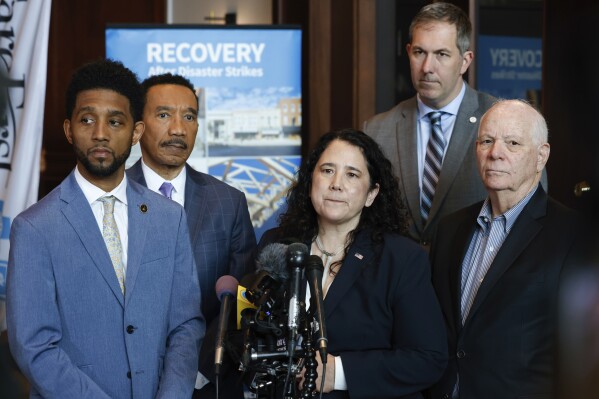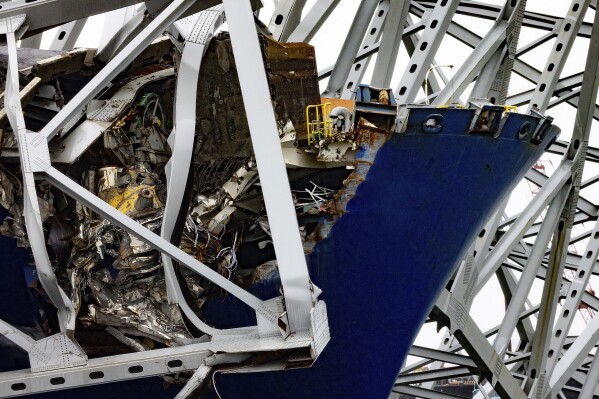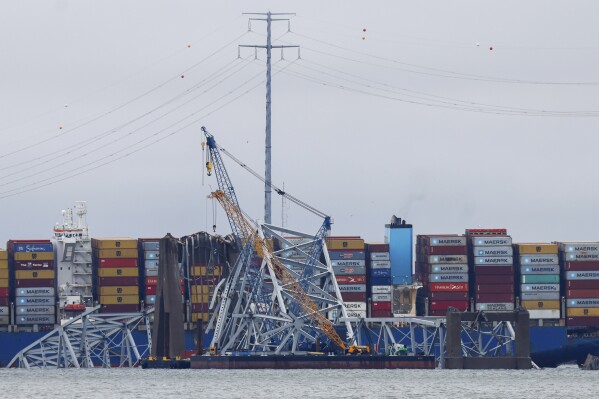What we know about the Baltimore bridge collapse as the cleanup gets underway
BALTIMORE (AP) — The U.S. government’s plans for clearing a collapsed Baltimore bridge and the cargo ship that struck it are coming into focus.
Federal and state authorities are also ramping up efforts to soften the economic blow to the port city’s businesses and residents who work in the maritime industry.
At the same time, questions are being raised about the precautions taken to protect the construction workers who died when the bridge collapsed March 26.
And it turns out that a floating crane that’s removing debris has ties to a top-secret CIA mission during the Cold War.
Here’s what we know about the Baltimore bridge collapse as the cleanup gets underway:
What is the plan for clearing the wreckage?
The U.S. Army Corps of Engineers released a salvage operations plan Wednesday evening that outlines its priorities and objectives for clearing the Patapsco River.
Top objectives include stabilizing the Dali container ship and eventually removing the massive vessel. The other goals are analyzing the tangle of wreckage of what was the Francis Scott Key Bridge and removing the debris.
The Army Corps said the ship is already stabilized and floating cranes are in position. Crews have begun taking away bridge wreckage from the Dali, while experts are already analyzing piles of debris in the water.



In terms of priorities, the Corps said recovering the bodies of the construction workers who died is at the top of the list. Weather conditions and the river’s murky water have been making the task difficult.
Other top priorities include establishing a limited access channel for ships and clearing the bridge debris from the Dali.
The second and third-tier priorities are removing the ship and then clearing the remaining wreckage from the river.
“The situation remains dynamic, and the plan ... will be continually updated as the engineering data becomes known,” the Army Corps said.
How are affected businesses and workers getting help?
Isabel Casillas Guzman, the administrator of the U.S. Small Business Administration, visited Baltimore on Thursday to highlight a low-interest loan program that’s available to affected businesses.
The program has received 500 applications, Guzman said, and the funds could start being distributed within about two weeks.
The loans will help keep companies afloat as Baltimore’s vital port remains closed to most maritime traffic. Guzman said businesses involved in transportation and supply chain logistics will likely suffer the most in the short term, but the long-term ripple effects will be widespread.
The Maryland Senate unanimously approved a bill Wednesday night authorizing the governor to use the state’s rainy day fund to help unemployed port employees. The bill heads next to the state House, which could approve it this week to send it to Gov. Wes Moore.
The legislation also would let the governor use state reserves to help some small businesses avoid layoffs and encourage companies that relocate elsewhere to return to Baltimore once the port reopens.
What safety measures were in place for the construction workers who died?
The deaths of the construction workers have raised questions about whether the company they worked for took proper precautions, including keeping a safety boat nearby that might have been able to warn them at least a few seconds before impact.
Federal regulations require construction companies to keep such boats, commonly known as skiffs, on hand whenever crews are working over waterways, safety experts told The Associated Press. There is no indication that the Brawner construction company had a rescue boat on the water or ready to be launched as the bridge fell.
Coast Guard representatives and other officials said they were unaware of any Brawner boat in the water at the time of the collapse. And satellite images from around the time appeared to show no skiff in the river near the bridge.
Even if the workers had been warned that the giant ship was about to hit, it’s unclear if they would have had enough time to scramble to safety.
A Brawner representative declined to comment, saying the company is focused on taking care of the families of the workers, who were filling potholes on the bridge when it collapsed.
Why is one floating crane getting so much attention?
Meanwhile, it turns out that one of the floating cranes clearing debris had a small but significant role during the Cold War.
In the early 1970s, the crane barge helped to construct a specialized ship that eventually raised a portion of a sunken Soviet submarine. Specifically, the crane hoisted into the ship heavy machinery that was vital to the CIA’s top-secret mission.
The equipment included a mechanical claw, tons of steel pipe and a heavy duty hydraulic system. The Soviet submarine was roughly 3 miles (5 kilometers) below the surface of the Pacific.
“It’s considered one of the most expensive intelligence operations of all time,” said M. Todd Bennett, a history professor at East Carolina University in Greenville, North Carolina, who wrote a 2022 book on the mission. ”And not only that, it’s certainly one of the most inventive or daring intelligence operations in U.S. history.”
The floating crane is now called the Chesapeake 1000, nicknamed “Chessy,” and is one of the largest of its kind on the East Coast.
Disclaimer: The copyright of this article belongs to the original author. Reposting this article is solely for the purpose of information dissemination and does not constitute any investment advice. If there is any infringement, please contact us immediately. We will make corrections or deletions as necessary. Thank you.





